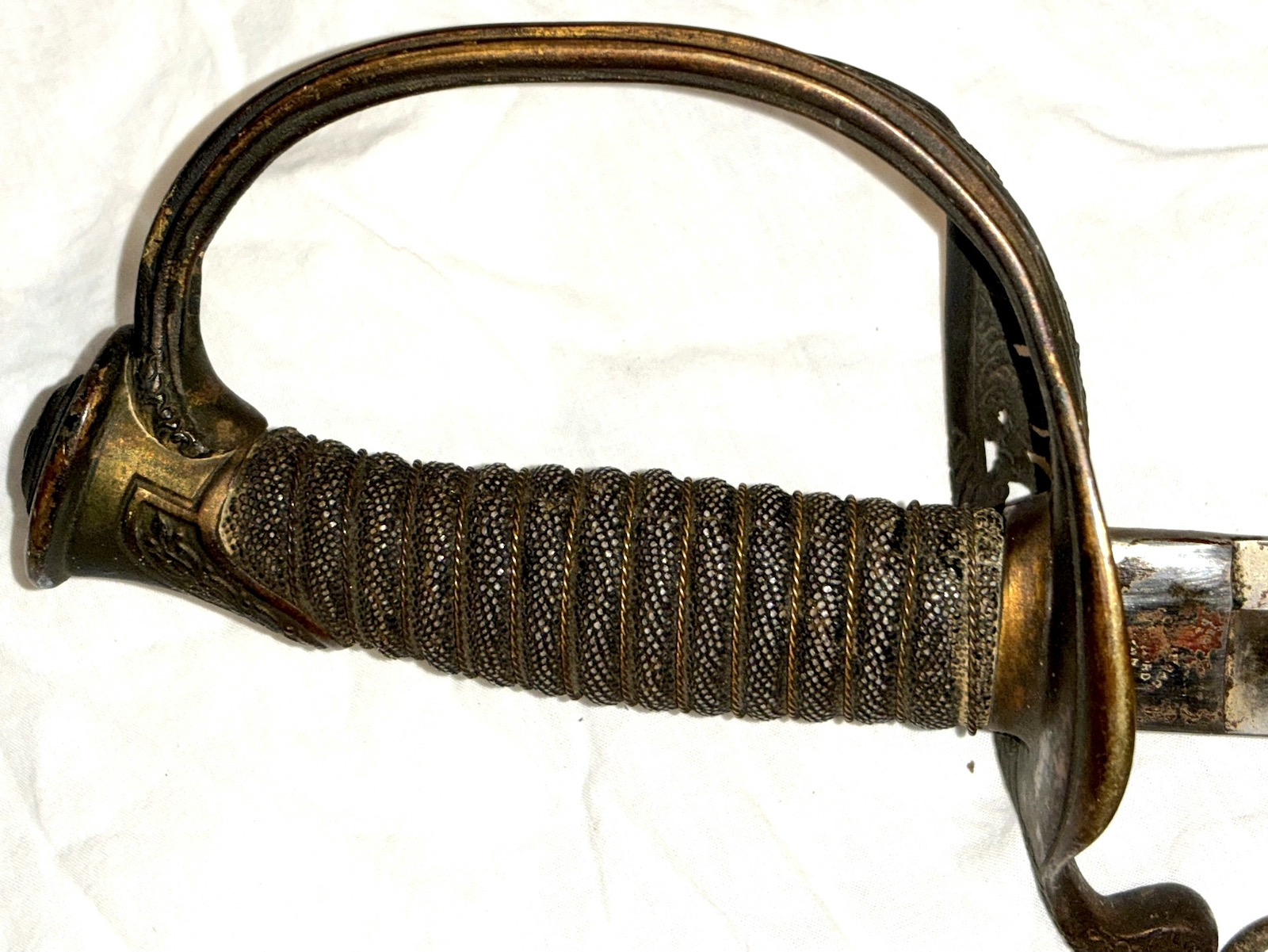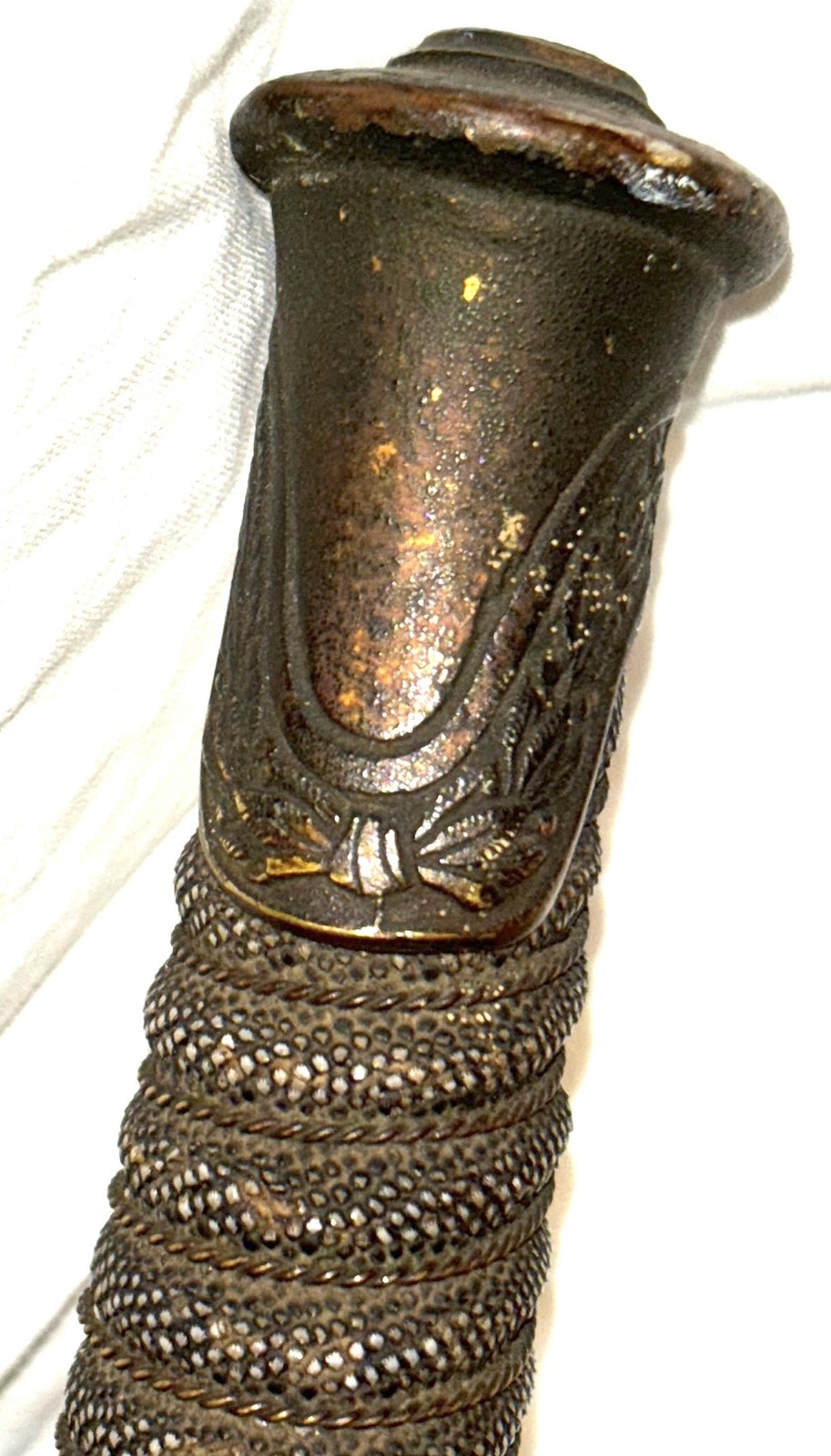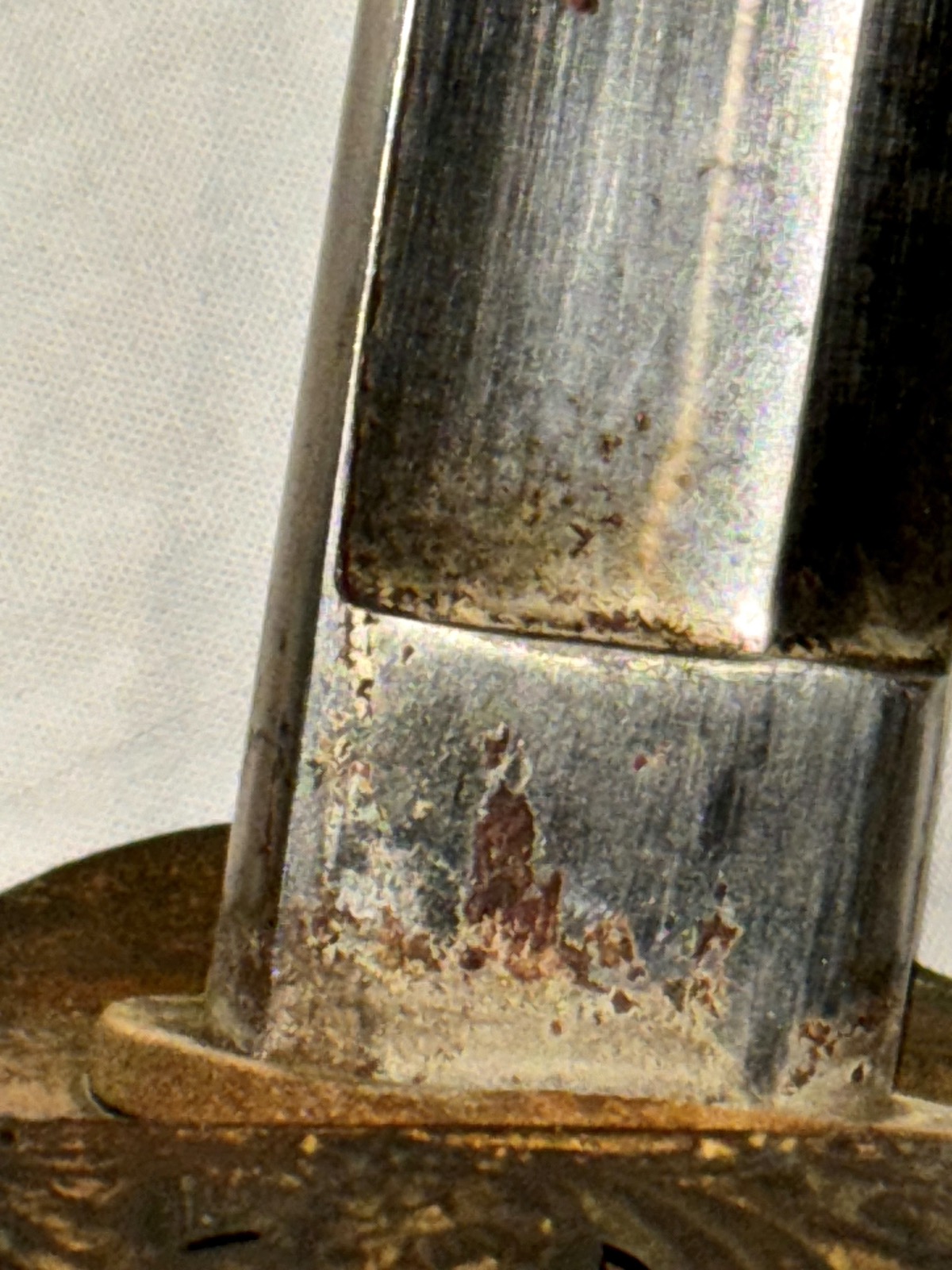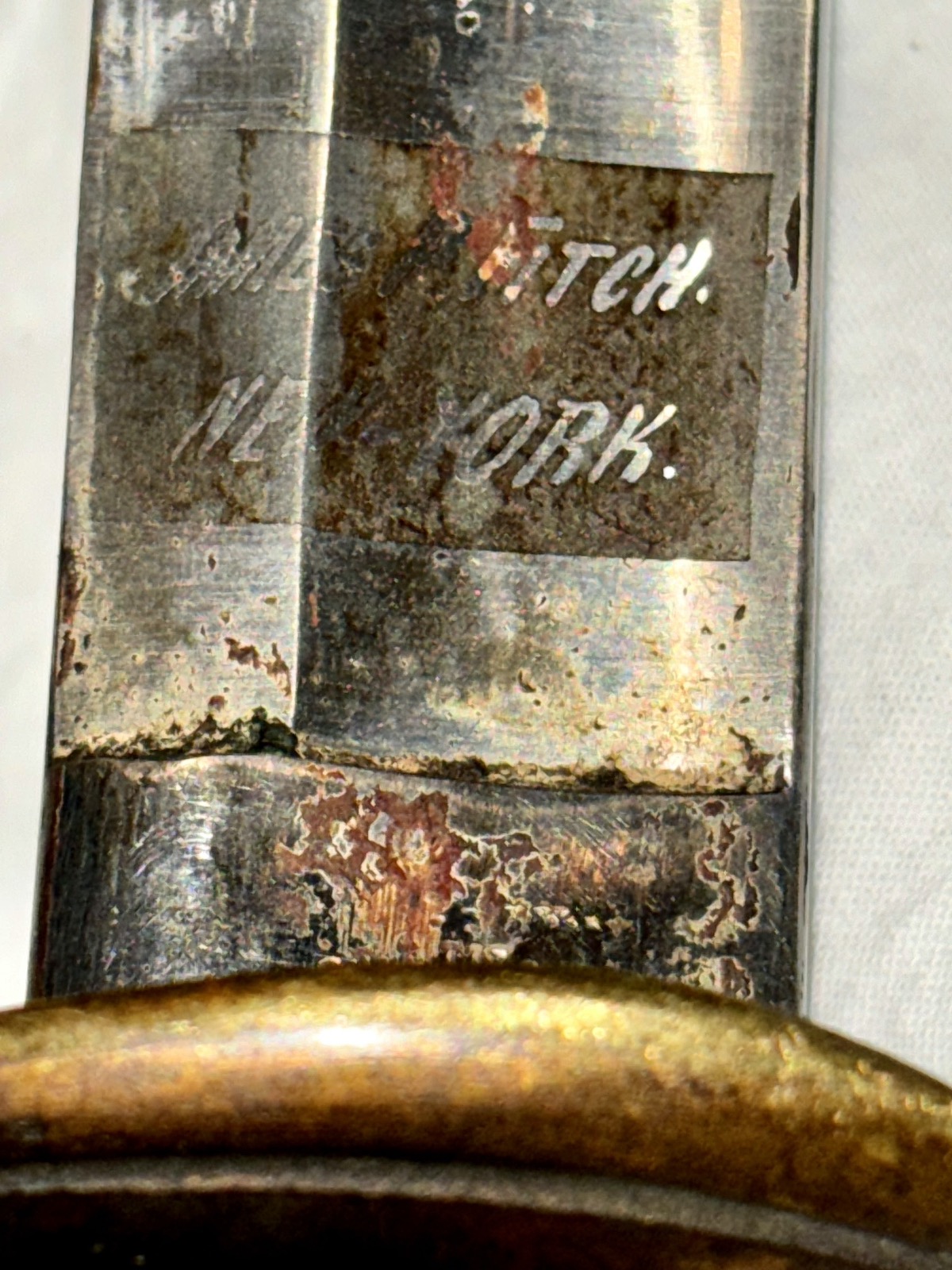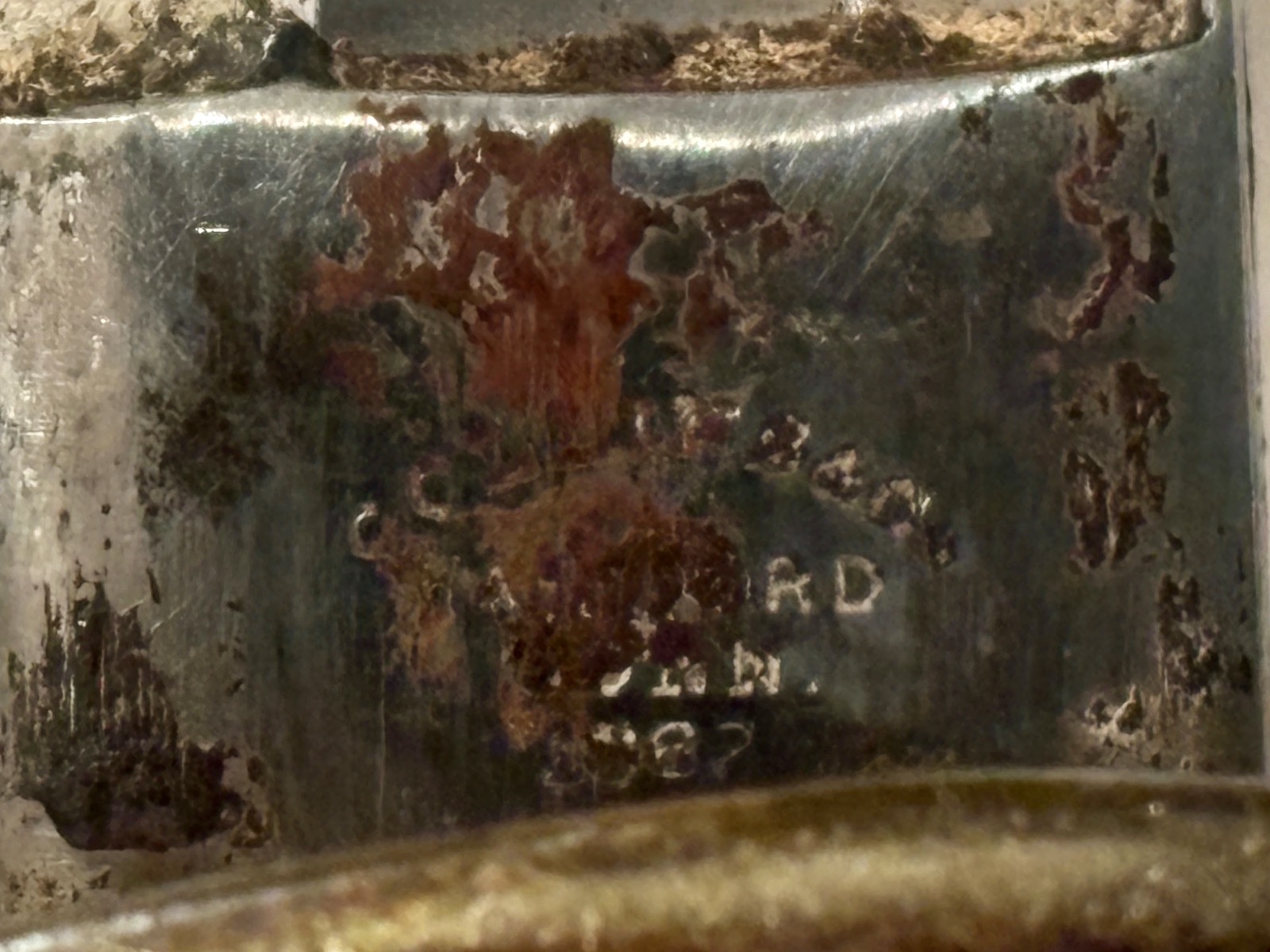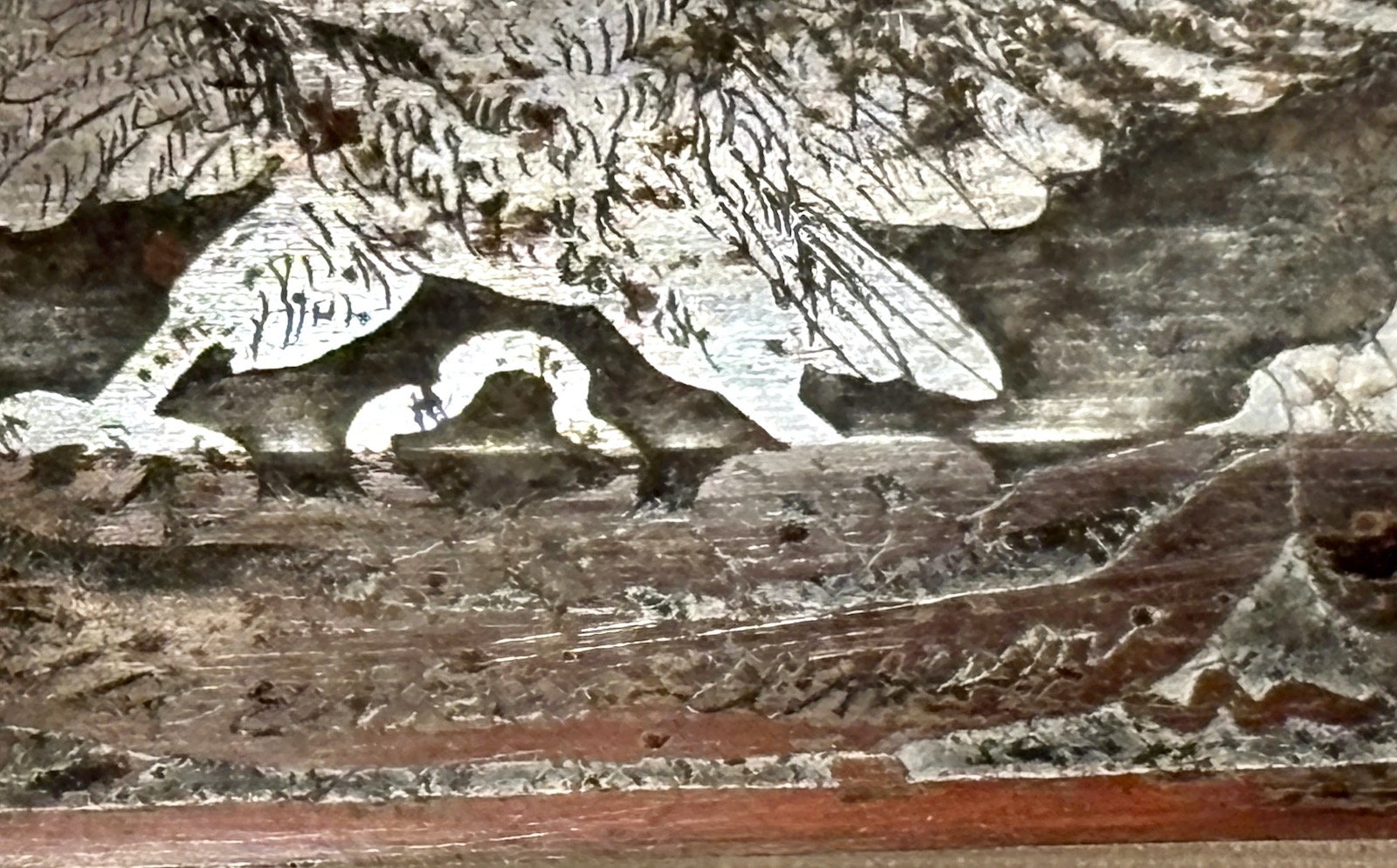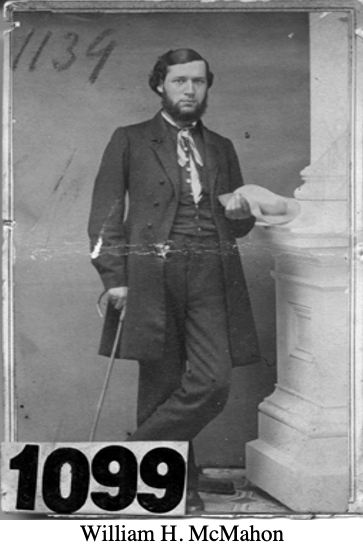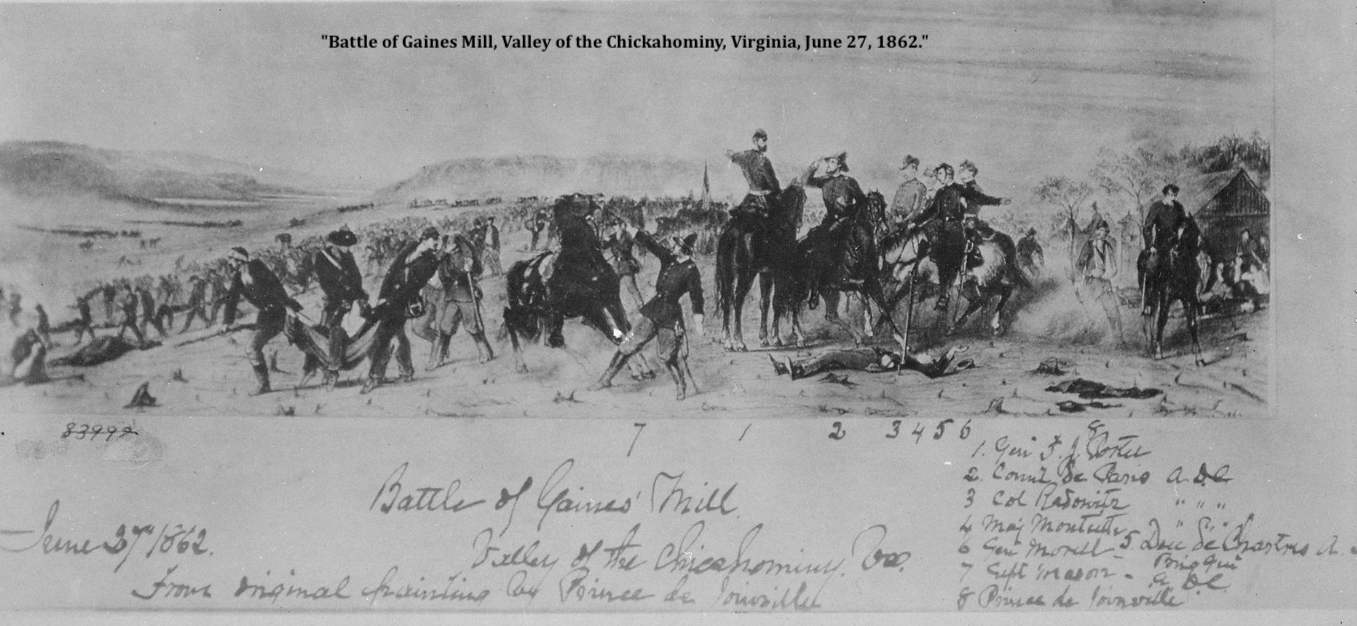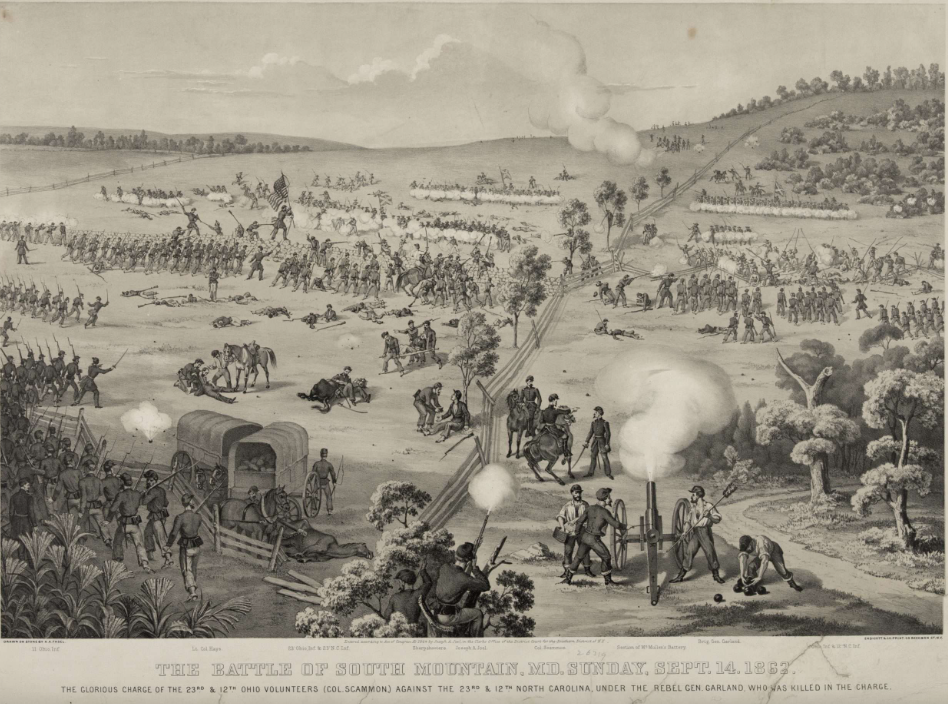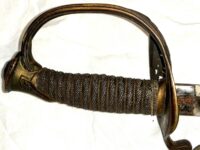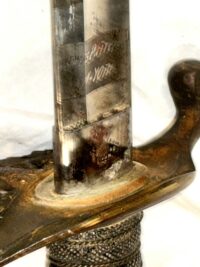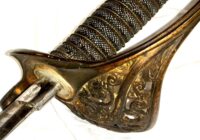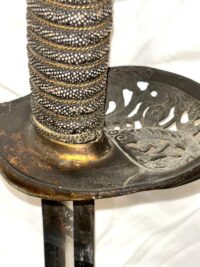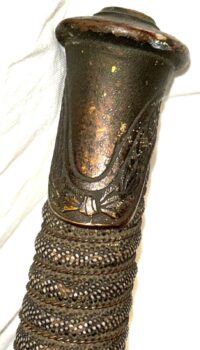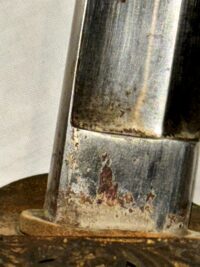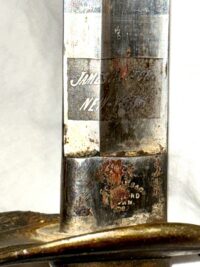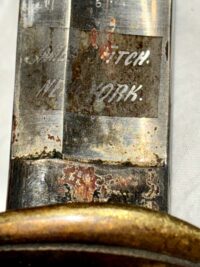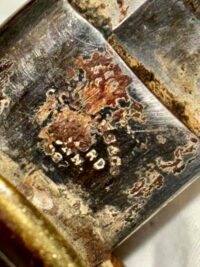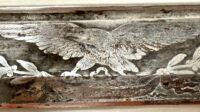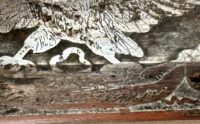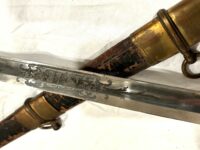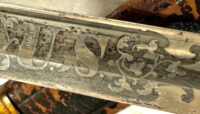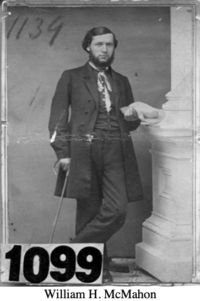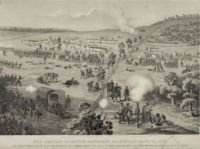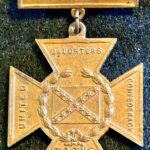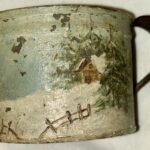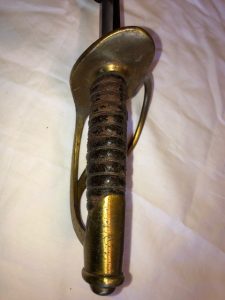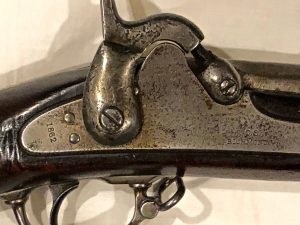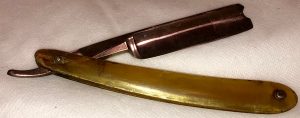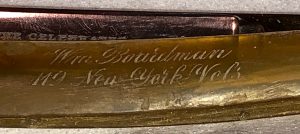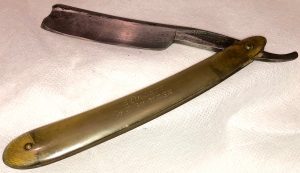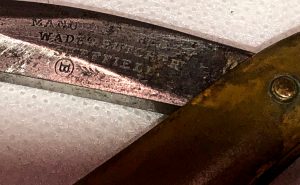M1850 Foot Officers’ Sword Presented to Lt. William McMahon of Co. G 27th New York Infantry for Gallantry at the Battles of Gaines Mill and South Mountain; Blade Etched and Retailed by J.P. Fitch of New York City in 1862
SOLD
M1850 Foot Officers’ Sword Presented to Lt. William McMahon of Co. G 27th New York Infantry for Gallantry at the Battles of Gaines Mill and South Mountain; Blade Etched and Retailed by J.P. Fitch of New York City in 1862 – This Model 1850 Foot Officers sword exhibits an engraved presentation on the brass, upper sword mount that states the following:
“Lieut. Wm H. McMahon
from the
Citizens of Lima
for
Gallant Conduct
at the Battles of
Gaines Mills
and
South Mountain”
Although the brass hilt of the sword exhibits the regulation pattern, open work and floral scrolls in the guard, it and all of the other brass elements were originally gilded; distinct traces of the original gilding remain visible on the hilt, scabbard mounts and the drag. There is twisted, brass wire in the furrows of the grip which is covered with shark skin; it remains in excellent condition. All brass elements exhibit an age, darkened patina from period use; we have chosen not to enhance any of these metallic aspects. The scabbard is leather, with two brass belt mounts and drag; there is some finish loss on the scabbard, but it remains sound, with some slight weakness just distal to the top of the drag. The original leather “washer” remains at the junction of the blade and the hilt.
The sword’s blade, exhibiting a mirror-like appearance, is marked, on the reverse side of the ricasso, as follows:
“Collins & Co.
Hartford Conn
1862”
The Collins Company was an established supplier of sword blades to various Civil War period retailers. Significantly, etched just above the Collins Company marking, distal to the ricasso , in a frosted panel, is the following:
“JAMES P. FITCH.
NEW – YORK.”
The mirrored appearance of the blade extends, distally from the Fitch, name panel, to a frosted panel with its ends ornamented by spear point leaves; within the panel itself are scrolled floral motifs, giving way to an etched, block lettered “US”. Distal to this panel, the blade returns to its mirrored finish. On the sword blade’s obverse side, the ricasso is blank. On this side of the blade, a mirror finish yields to an etched panel, with frosted ends, with spearpoint leaves and decorative scrolls at each end of the panel, highlighted by a centrally located American Eagle with outstretched wings and etched feathers; the eagle is perched on a leafy branch beneath which is engraved, in script: “E Pluribus Unum”. Distal to this panel, as on the reverse side, the blade returns to its mirrored finish.
James P. Fitch began his military goods career with Schuyler, Hartley & Graham, then started his own militaria, retail business, in New York City, in September, 1862. As did other military goods retailers prior to and during the Civil War, Fitch did not actually manufacture sword blades and other sword components, but purchased them from other companies; with this sword, Fitch purchased the blade and other components from the Collins Company, of Hartford, Connecticut; Fitch then acid etched his name and decorative elements on the blades, as well as engraving presentation attributions on the sword mount and gilding the brass elements. Fitch remained in business, by himself, until January, 1863, when he formed a partnership with Howard Waldo; thus, there is a confined window of time during which this sword was made by Collins and artfully appointed by James Fitch, between September, 1862 and January, 1863.
This is a unique sword, appointed by a rarely encountered, Civil War retailer and awarded to a gallant, New York, infantry officer. The sword appears to have been carried by Lt. McMahon, during his tenure with the 27th New York, but it remains in overall, very good condition.
The sword’s blade measures approximately 31” in length
William H. McMahon
|
| Name | William H McMahon |
| Age | 22 |
| Birth Year | abt 1839 |
| Enlistment Year | 1861 |
| Enlistment Location | Lima, New York, USA |
| Muster Year | 1861 |
| Muster Regiment | 27th Infantry |
From the 27th Regiment
———-
[We are allowed to make the following extracts from a letter written by Will H. McMahon, lately from Lima Seminary, to a friend in this village. Mr. McMahon is a talented young man and a ready penman, and we should be pleased to hear from him often.]
Washington, D. C., July 27, 1861.
I have but a few moments, the first I have had in a long while to devote to correspondence. I was, of course, in the battle at Bull’s Run, but mist reserve the description of that scene until some other time. I have only this to say as regards pictures in the papers, none of them that I have seen represent the field at all; and the reporters’ accounts are hardly to be relied on. We were about forty hours on the march and in battle, without food, sleep or water, except such as we took from some loathsome pools and thick muddy brooks. I drank water which your educated Irish hog who occupies the same room with the family would scorn to be in. None of our fellow students were injured. The retreat was a regular rout, owing mostly to the inefficiency off our officers. The South have better officers, artillery and cavalry. We the best men. * * * —— flunked when it came to the pinch of fight or run. Where he was hid I don’t know, but we did not get the sight of his lovely features during the battle. He is spotted. * * * We (the 27th) were exposed for three-fourths of an hour to the fire of three regiments and two large masked batteries, and we drove the regiments off in double quick time, but our Colonel being wounded we had no chance of taking the batteries.
In the middle of the rout the road was covered with every thing you can imagine. I might have picked up any thing that I wished on the field, but was too weak to carry more than my arms, and hat I ten thousand dollars I would willingly have given it all for one drink of ice water! I saw many truly horrible sights during the contest, but the shrieks of dying horses were much more shocking even than the groans of wounded and dying men. Our regiment lost heavily. If I live through our next engagement it will be almost a miracle. The two men who stood on each side of me were wounded, and the Col. was hit while I was yelling in his ear about a flag! * * But if I do live through it I intend to strip a rebel of something which I can mail and sent to you * * There is now (eight o’clock Saturday evening) heavy cannonading in the distance over the river. * * We can whip them every time, with good officers and two-thirds the men.
But I must stop writing and prepare for emergencies. Write immediately.
Yours in brotherhood,
WILL.
Dansville [NY] Advertiser, 8/8/1861
Contributed by John Hennessy
William H. McMahon – no entry at Ancestry.com. Found in roster of the regiment in History of the 27th Regiment New York Volunteers, p. 280: “promoted to Corporal, Nov. 7, 1861; to Second Lieutenant of Co. K, Sept. 11, 1862.”
Company G Lima Volunteers: CAPT. J PERKINS
The company was accepted in state service for two years at Lima, Livingston County, New York, on 7 May, 1861, and was mustered in United States service for two years at Barracks No.4, Young Man’s National Agricultural Association Fairgrounds, opposite Fosters Pond, south of Water Street and west of Hoffman Street, one and a half miles west of Elmira, Chemung County, New York, by Captain L Sitgreaves, United States Topographical Engineers, on 10 July, 1861, dated 21 May, 1861. Captain J Perkins, 27th New York Infantry, Company G, was not fit for duty and Second Lieutenant H S Hall, 27th New York Infantry, Company G, was assigned to command the company at the first battle of Bull Run on 21 July, 1861. Captain J Perkins, 27th New York Infantry, Company G, resigned on 7 November, 1861.
27th NY Infantry
( 2-years )
| Organized: Elmira, NY on 5/21/61 Mustered Out: 5/31/63 at Elmira, NYOfficers Killed or Mortally Wounded: 2 Officers Died of Disease, Accidents, etc.: 2 Enlisted Men Killed or Mortally Wounded: 72 Enlisted Men Died of Disease, Accidents, etc.: 70 (Source: Fox, Regimental Losses) |
| From | To | Brigade | Division | Corps | Army | Comment |
| Jun ’61 | Aug ’61 | 1 | 2 | Department of Northeastern Virginia | New Organization | |
| Aug ’61 | Oct ’61 | Heintzelman’s | Army of Potomac | |||
| Oct ’61 | Mar ’62 | 2 | Franklin’s | Army of Potomac | ||
| Mar ’62 | Apr ’62 | 2 | 1 | 1 | Army of Potomac | |
| Apr ’62 | May ’62 | 2 | 1 | Department of Rappahannock | ||
| May ’62 | May ’63 | 2 | 1 | 6 | Army of Potomac | Mustered Out |
NEW YORK
TWENTY-SEVENTH REGIMENT OF INFANTRY.
(Two Years)
|
Twenty-seventh Infantry.-Cols., Henry W. Slocum, Joseph J. Bartlett, Alexander D. Adams, Lieut.-Cols., Joseph J. Chambers, Alexander Duncan Adams, Joseph H. Bodine; Majs., Joseph J. Bartlett, Curtiss C. Gardiner, Joseph H. Bodine, George G. Wanzer.
The 27th, the “Union Regiment,” was composed of three companies from Broome county, one company from each of the following counties: Westchester, Wayne, Monroe, Wyoming and Orleans, and two companies from Livingston. It was mustered into the U. S. service for a two years’ term at Elmira on July 9 and 10, 1861, to date from May 21, and left the state for Washington on July 10.
It was quartered at Franklin Square until July 17 and on that day advanced toward Manassas, assigned to the 1st brigade, 2nd division, and received its baptism of fire in the battle of Bull Run, where 130 members were killed, wounded or missing, Col. Slocum being among the wounded.
The command was withdrawn to Washington after the battle and again occupied its old camp at Franklin Square until late in September, when it was ordered to Fort Lyon and there attached to Slocum’s brigade, Franklin’s division. On March 13, 1862, it became a part of the 2nd brigade, 1st division, 1st corps, Army of the Potomac, and in May the division was assigned to the 6th corps.
The regiment left camp for the Peninsula in April, participated in the battle of West Point, the siege of Yorktown and the Seven Days’ battles, suffering heavy losses at Gaines’ mill and Malvern hill. It was more fortunate at the second Bull Run, where it was present but not closely engaged. The regiment then participated in the battles of South Mountain, Antietam and Fredericksburg, established winter quarters at Belle Plain, shared the discomforts of the “Mud March,” lost 19 members killed, wounded or missing in the Chancellorsville campaign in May, 1863, and soon after returned to New York. It was mustered out at Elmira May 31, 1863, having lost during its term of service 74 members by death from wounds and 74 by accident, imprisonment or disease. |
27th Infantry Regiment
Nickname: Union Regiment
Mustered in: May 21, 1861
Mustered out: May 31, 1863
THE FOLLOWING IS TAKEN FROM NEW YORK IN THE WAR OF THE REBELLION, 3RD ED. FREDERICK PHISTERER. ALBANY: J. B. LYON COMPANY, 1912.
This regiment, Col. Henry W. Slocum, was accepted by the State May 21, 1861; organized at Elmira, and there mustered in the service of the United States for two years July 9th and 10th, to date from May 21, 1861. Its three years’ men were, in May, 1863, transferred to the 121st Infantry.
The companies were recruited. A at White Plains; B at Lyons, of members of the 54th State Militia, C, D and F at Binghamton; E at Rochester; G at Lima; H at Mt. Morris; I at Angelica; and K at Albion; the men were principally from the counties of Allegany, Broome, Livingston, Monroe, Ontario, Orleans and Wayne.
The regiment left the State July 10, 1861; served at Washington, D. C, from July 12, 1861; in 1st Brigade 2d Division Army of Northeastern Virginia from July 16, 1861; in Heintzelman’s Brigade, Division of Potomac, from August 4, 1861; in Slocum’s Brigade, Franklin’s Division, Army of the Potomac, from October 15, 1861; in 2d, the same, Brigade, 1st Division, 1st Corps, Army of the Potomac, from March 13, 1862; in 2d Brigade, 1st Division, 6th Corps, Army of the Potomac, from May, 1862; and was honorably discharged and mustered out, commanded by Col. Alexander D. Adams, May 31, 1863, at Elmira.
During its service the regiment lost by death, killed in action, 1 officer, 61 enlisted men; of wounds received in action, 1 officer, 11 enlisted men; of disease and other causes, 2 officers, 72 enlisted men; total, 4 officers, 144 enlisted men; aggregate, 146; of whom 7 enlisted men died in the hands of the enemy.
THE FOLLOWING IS TAKEN FROM THE UNION ARMY: A HISTORY OF MILITARY AFFAIRS IN THE LOYAL STATES, 1861-65 — RECORDS OF THE REGIMENTS IN THE UNION ARMY — CYCLOPEDIA OF BATTLES — MEMOIRS OF COMMANDERS AND SOLDIERS. MADISON, WI: FEDERAL PUB. CO., 1908. VOLUME II.
Twenty-seventh Infantry.—Cols., Henry W. Slocum, Joseph J. Bartlett, Alexander D. Adams; Lieut-Cols., Joseph J. Chambers, Alexander Duncan Adams, Joseph H. Bodine; Majs., Joseph J. Bartlett, Curtiss C. Gardiner, Joseph H. Bodine, George G. Wan-zer. The 27th, the “Union Regiment,” was composed of three companies from Broome county, one company from each of the following counties: Westchester, Wayne, Monroe, Wyoming and Orleans, and two companies from Livingston. It was mustered into the U. S. service for a two years’ term at Elmira on July 9 and 10, 1861, to date from May 21, and left the state for Washington on July 10. It was quartered at Franklin Square until July 17 and on that day advanced toward Manassas, assigned to the 1st brigade, 2nd division, and received its baptism of fire in the battle of Bull Run, where 130 members were killed, wounded or missing, Col, Slocum being among the wounded. The command was withdrawn to Washington after the battle and again Occupied its old camp at Franklin Square until late in September, when it was ordered to Fort Lyon and there attached to Slocum’s brigade, Franklin’s division. On March 13, 1862, it became a part of the 2nd brigade, 1st division, 1st corps, Army of the Potomac, and in May the division was assigned to the 6th corps. The regiment left camp for the Peninsula in April, participated in the battle of West Point, the siege of Yorktown and the Seven Days’ battles, suffering heavy losses at Gaines’ Mill and Malvern hill. It was more fortunate at the second Bull Run, where it was present but not closely engaged. The regiment then participated in the battles of South mountain, Antietam and Fredericksburg, established winter quarters at Belle Plain, shared the discomforts of the “Mud March,” lost 19 members killed, wounded or missing in the Chancellorsville campaign in May, 1863, and soon after returned to New York. It was mustered out at Elmira May 31, 1863, having lost during its term of service 74 members by death from wounds and 74 by accident, imprisonment or disease.
27th New York Infantry Regiment’s Civil War Historical Sketch
From The 3rd Annual Report Of The Bureau Of Military Statistics
TWENTY-SEVENTH REGIMENT INFANTRY, N. Y. S. V. The Twenty-seventh regiment infantry, N. Y. S. V., was organ¬ized at Elmira on the 21st of May, 186.1. It was composed of companies recruited and accepted as follows, viz:
| Co. | Where recruited | By whom recruited | Order | Date of acceptance |
| A | White Plains, Westchester co. | Capt. Joseph J. Chambers | 282 | April 30, 1861 |
| B | Lyons, Wayne county | Capt. Alexander D. Adams | 359 | May 2, 1861 |
| C | Binghamton, Broome county | Capt. Jos. J. Bartlett | 349 | May 2, 1861 |
| D | Binghamton, Broome county | Capt. Hiram C. Rogers | 360 | May 2, 1861 |
| E | Rochester, Monroe county | Capt. George G. Wanzer | 512 | May 7, 1861 |
| F | Binghamton, Broome county | Capt. Peter Jay | 531 | May 8, 1861 |
| G | Lima, Livingston county | Capt. James Perkins | 538 | May 7, 1861 |
| H | Mount Morris, Livingston co | Capt. Charles E. Martin | 605 | May 11, 1861 |
| I | Perry, Wyoming county | Capt. Curtis C. Gardner | 613 | May 13, 1861 |
| K | Albion, Orleans county | Capt. Henry L. Achilles, jr. | 642 | May 16, 1861 |
The companies were organized into a regiment by General Van Valkenburgh, and the following field officers elected, viz: Henry W. Slocum, Colonel; Joseph J. Chambers, Lieutenant Colonel; and Joseph J. Bartlett, Major. The State Military Board, on the 21st of May (Special Orders 208), confirmed this election, accepted the regiment and numbered it, and directed Colonel Slocum to report to General Van Valkenburgh, and to hold his regiment in readiness to be mustered into the service of the United States. Company I was mustered into the service of the United States, July 9th, and the remaining companies and field and staff on the 10th. The muster, however, was for two years from May 21st.
The regiment was supplied with uniforms, and arms, tents, &c., and left the State on the 10th of July for Washington via Harris¬burg and Baltimore. The total expenditure by the State, on ac¬count of the regiment, up to the 15th of August, 1861, was $38,617.75, exclusive of subsistence and quarters.
On its arrival in Washington, the regiment was quartered in tents on Franklin Square. A movement against the enemy was then under discussion, and Colonel Slocum and Major Bartlett sought an interview with the war department with a view to have the regiment assigned to the field. In this request they were gratified, and on the 17th of July it took up the line of march from Washington, as a part of the First brigade (Col. Andrew Porter), of the Second division (Gen. Hunter’s).
It reached Annandale on the evening of the 17th, Fairfax Court House on the 18th, and entered the battle of Bull Run on the 21st. Its first encounter was with the Twenty-seventh Virginia, which fell hack. It then met the Eighth Georgia, which fell back until reinforced, when the regiment was in turn repulsed, and took ref¬uge under a hill. It was soon after ordered to charge a battery stationed on a knoll, and moved to the work under a heavy fire, which soon fold with fearful effect upon the ranks of the regiment; Colonel Slocum was wounded, the color guard was reduced from nine to two, and the movement was abandoned. Major Bartlett succeeded Colonel Slocum and kept the regiment well in hand. It was engaged in another encounter, and finally retired from the field and reached the road, where the confusion attending the retreat of the army broke it up, as was the case with other regi¬ments actively engaged in the battle. Portions of the regiment reached Fort Corcoran about 9 o’clock on the 22d, and at noon it was partially reorganized and marched to Camp Anderson, Frank¬lin Square.
The regiment remained in Washington Until September, when it was assigned to General Slocum’s brigade (with the Sixteenth N. Y.), of General Franklin’s division, and moved to the site of Fort Lyon.
It was engaged in the construction of this Fort during the fall of 1861, and spent the winter in “Camp Franklin.”
Under the order of March 13, 1862, the regiment, with its brigade and division, was attached to General McDowell’s (First) corps. On the 16th of April, General Franklin and General Smith’s divisions were detached from General McDowell’s corps, and on the 7th of May, were organized as the Sixth corps, under command of General Franklin—General Slocum succeeding Gen. Franklin in the command of the division. This arrangement was not subsequently changed during the term of service of the regi¬ment, although the officers in command were changed, General Bartlett succeeding to the command of the brigade, General Brooks to the division, and General Sedgwick to the corps.
The movements were substantially those of the Sixteenth New York. It participated in the siege of Yorktown, and embarked with Franklin’s division for West Point, where it landed on the 6th ; skirmished with the enemy, and on the 7th supported bat¬teries. It was engaged at Gaines’ Mill* (*At 2 p. M., Gen. Porter asked for reinforcements, Slocum’s division of he 6th corps was ordered to cross to the left bank of the river, by Alexander’s bridge, and proceed to his support. At 3.30 P. M., Slocum’s division reached the field, and was immediately brought into action at the weak points of our line.) on the 27th of June, and lost heavily; crossed the Chickahominy at 3 P. M., and went into action about 5 P. M., on the extreme right of Porter’s corps—drove the enemy from his position by a bayonet charge, and captured a large number of prisoners. It held its position until dark, when, after expending all it’s ammunition, it was ordered to retire.
On the 30th, at Charles City Cross Roads,* (* Gen. Slocum’s division was on the right of the Charles City road. Gen. Slocum’s divi¬sion was to extend to the Charles City road, Gen. Kearney’s left to connect with Gen. Slocum’s left. * * At half past two the attack was made down the road on Gen. Slo¬cum’s left, but was checked by his artillery.—Gen. McClellan’s Report.) it skirmished and supported batteries, and at Malvern Hill (July 1st), was sent early in the action to the right of the army to prevent a flank movement by the enemy. During the entire seven days fight it was under fire every day.
The regiment moved with its division from the Peninsula in August, and from thence to the second Bull Run battle. (Aug. 30th.) Here it was thrown to the front to check the advance of the enemy and to cover the retreat of Gen. Pope, but was not particularly or heavily engaged. It followed the retreat to Alex¬andria, and went into camp at Fort Lyon. On the 6th of Sep¬tember, the regiment crossed the Long Bridge and marched through Washington to Tenallytown. It continued on the march of the Maryland campaign, and reached South Mountain on the 14th. Here it opened the fight (Crampton Gap) as skirmishers, and subsequently advanced with its brigade (Bartlett’s) upon the enemy at a charge on the right. The enemy were driven up and over the mountain, and the regiment rested on its crest after an action of three hours.* (* Slocum’s division was formed on the right of the road leading through the gap, and Smith’s upon the left. A line formed of Bartlett’s and Torbett’s brigades, supported by Newton, whoso activity was conspicuous, advanced steadily upon the enemy at a charge on the right. The enemy were driven from their position at the base of the mountain, where they were protected by a stone wall, steadily forced back up the slope until they reached the position of their battery on the road, well up the mountain. There they made a stand. They were however driven back, retiring their artillery in echelon until, after an action of three hours, the crest was gained, and the enemy hastily fled down the mountain on the other side.—Gen. McClellan’s Report.)
At Antietam, on the 17th, it supported batteries, under heavy fire of artillery all day. From Antietam the regiment moved with its corps to Belle Plain, where it arrived on the 4th of December. In the movement on Fredericksburg, it was the first regiment that crossed the Rappahannock in the left grand division; drove the enemy’s skirmishers back from the river, and was more or less under fire during the 13th, 14th and 15th. It then went into camp and remained until the “mud march” of January, in which it participated.
In the movement under Gen. Hooker in May, the regiment was engaged in the capture of Marye’s Heights, and was subsequently thrown to the front as skirmishers, and covered the retreat of the corps (sixth) until it reached the fortifications at Banks’ Ford. It then returned to Belle Plain, and thence to Elmira, where it was mustered out on the 31st of May, 1863. It numbered about five hundred and forty, men and officers, when mustered out. The several companies were received with fitting marks of popular regard in their localities.





